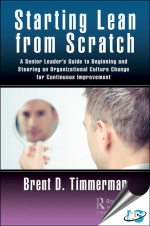Tab Article
What if the problem is you? For organizations just preparing to begin a continuous-improvement (CI) journey, the behaviors of the leadership must transform dramatically for the Lean toolkit to succeed. Many organizations invest in training colleagues about the power of the tools but fail to address the behavior and mindset of the leadership. Unfortunately, misaligned leadership behaviors will counteract any culture change that is attempted simply by pushing the use of Lean tools. This book outlines a comprehensive set of leadership principles that must be understood and modelled by the leadership before the CI Journey can effectively begin.
This book organizes these leadership principles into a framework of a conceptual model called the "Three Spaces of Lean Transformation." The model suggests that these spaces of Trust, Change, and Continuous Improvement must be consciously shaped, developed, and maintained by the organizational leadership if a continuous improvement culture change succeeds. This book organizes a set of leadership principles -- that supports the culture change -- into each of these three spaces.
The book is written in the first-person narrative and maintains a mentoring format. This book is for professionals at the very beginning of an intimidating Lean journey and with very little background or formal Lean training.
Although these leadership principles are framed in the approach of being necessary to support an innovation culture change, the principles are, in fact, those necessary to support effective employee engagement. In addition, this set of leadership principles, if modeled consistently by the leaders, will create an organizational culture that will attract and retain great employees.
These principles form the strong leadership foundation that must be established in organizations where, previously, many of the leadership behaviors were contrary to what is required by a "Lean" organization. The proper adoption of these leadership principles by an organization will support the long-term success of the Lean journey, and that this will enable a lasting, not a temporary, change to a continuous improvement culture.


